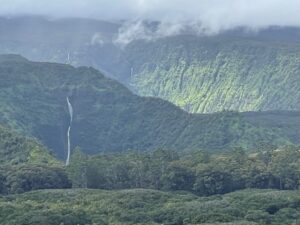 Saying he doesn’t want to see East Maui stream water potentially wasted, First Circuit Court Judge Jeffrey Crabtree Tuesday reduced the permitted amount of water that Mahi Pono and Alexander & Baldwin (operating as EMI) may divert from East Maui streams from 25 million gallons of water a day [mgd], to 20 mgd. That decision will last for the next 45 days, or until the Board of Land and Natural Resources [BLNR] finalizes its decision in a contested case hearing held on the same subject last December (more on that in a minute).
Saying he doesn’t want to see East Maui stream water potentially wasted, First Circuit Court Judge Jeffrey Crabtree Tuesday reduced the permitted amount of water that Mahi Pono and Alexander & Baldwin (operating as EMI) may divert from East Maui streams from 25 million gallons of water a day [mgd], to 20 mgd. That decision will last for the next 45 days, or until the Board of Land and Natural Resources [BLNR] finalizes its decision in a contested case hearing held on the same subject last December (more on that in a minute).
Crabtree said he based his decision on East Maui Irrigation’s water usage reports that showed the company has not used more than 19 mgd of water a day since his decision last July to curtail EMI’s water diversion from 45 mgd to 25 mgd.
“45 days is not a lot of time in the grand scheme of things,” Crabtree told lawyers. “But it’s a lot of water. For 45 days, that’s 225 million gallons. The court would much rather you come back to court if you need more water than potentially waste 225 million gallons.”
The judge’s ruling was made in response to a hearing requested by East Maui Irrigation in a battle involving EMI, Maui County, and the BLNR on one side, and Sierra Club on the other. This whole thing has been bouncing in and out of the court system for years now, largely due to excessive dithering on the part of the Board of Land and Natural Resources. EMI has seen the amount of East Maui stream water it is allowed to divert sliced more than 50% in the last nine months, due to repeated legal intervention on a number of fronts from Sierra Club. Here are highlights so far:
Long-running water fight
Mahi Pono—owned by the Canadian Public Sector Pension Investment Fund–became Maui’s largest landowner after buying 41,000 acres of Central Maui ag land and half of the 15,000-acre EMI water system in 2018. Since then, it has struggled to obtain the amount of East Maui water it wants to divert to irrigate Central Maui fields that remain largely unplanted. In 2020, it requested—and received—permission from the BLNR for four temporary water lease permits in East Maui allowing it to divert 45 mgd of water, mainly for use on its crops (the county of Maui uses a fraction of that amount for some upcountry users) during 2021.
Sierra Club challenged that BLNR decision and asked for a contested case hearing, which was denied. The environmental organization then went to court before Judge Crabtree. In July, 2021, stating that the BLNR and EMI had “offered nothing in the way of any options, plans or specifics” to justify diverting 45 mgd of water, Crabtree cut the allocation almost in half. He also ordered the BLNR to hold the contested case hearing, which it did in December, just weeks before the 2021 permits expired.
At that hearing, EMI now said it only wanted to divert 40 mgd of water per day for the 2022 permits. Sierra Club attorney David Kimo Frankel argued that EMI was wasting enormous amounts of East Maui stream water even with that slightly reduced amount. He said EMI couldn’t even store all the extra diverted water in its reservoirs, and that the reservoirs themselves were leaking, sending this Hawaii “trust resource” straight into the ground.
EMI’s argument: the “seepage” recharges the underlying aquifer, so that actually was a good thing.
The BLNR took the matter under advisement and a decision was expected sometime in January, 2022. In the meantime, EMI went back to Crabtree, who agreed to extend the 25 mgd water limit until May 1, after the BLNR’s pending decision had been issued, debated and (probably) appealed by one side or the other.
With the BLNR decision still not issued, EMI again went back to court to extend the extension. Which brings us to Tuesday.
5 mgd a month “adds up quickly”
During the hearing, EMI attorneys repeated many of the arguments used at the contested case hearing: that Mahi Pono’s new irrigation system improves water conservation, and that what Frankel calls reservoir “water waste,” is “seepage” that is good for the underlying aquifer.
Some interesting new facts also emerged during the hour-long hearing. EMI’s attorney said that the company had diverted less water during the first quarter of 2022 because of reduced rainfall over East Maui. It’s not that the water wasn’t needed, she told the judge, “There just wasn’t enough water there to be diverted to begin with.”
That doesn’t seem to bode well for EMI’s ultimate ask: for a 30-year permanent water lease to divert almost 90 mgd.
She also explained that Mahi Pono, which unveiled big planting plans for 2022 at the contested case hearing, hasn’t been able to plant much of anything so far this year. “There was a plan to plant certain trees, but the delivery of those trees has been delayed.” Delivery and planting is now expected during the third and fourth quarters of the year, she added.
“So it’s our position that there is no need to further reduce the amount of water that can be diverted.”
The judge interjected. “Okay, I’m still struggling with the fact that over the last nine months, you’ve never even needed 20 [mgd]. I mean, five million gallons a day sound like a lot, but boy, it adds up quickly. It’s 150 million gallons a month.”
And as for the reservoirs, Crabtree said, “There is some evidence that water in a reservoir equals waste, no matter how you cut it, because either they’re not lined or evaporating, or what have you. Why take it out of the streams until it’s proven it’s necessary?”
Sierra Club’s Frankel said Crabtree realized that EMI’s “claims to need more water are not supported by the data. The judge’s decision should ensure that more water stays in our streams. It should also encourage Mahi Pono to use water more efficiently.”
BLNR Decision
And now for the long-postponed BLNR decision in the contested case hearing. Was it mere coincidence that, after four months of silence, the agency’s proposed Findings of Fact were sent to the attorneys about 30 minutes before the hearing started?
Nobody is saying yet what is contained in that document, but you can be sure I will write about it when details appear.


